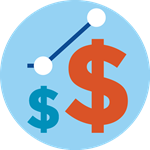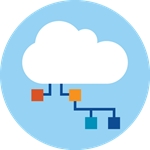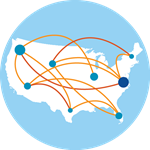Total Value-Added GDP:
$1.07 trillion
(includes indirect and induced impacts)
Direct Value-Added GDP:
$475.3 billion
Download the US Overview
Download the Report
Software is so much more than your desktop at work. Software is apps. Software is data. Software is cloud computing. It creates breakthroughs and drives growth in nearly every industry. Software empowers countless people and American businesses, and improves our lives each day in ways big and small. Along with all this progress comes the dramatic, positive impact software is making on our national economy each year. The Economic Impact of Software, a first-of-its-kind study from BSA | The Software Alliance conducted in 2016 by The Economist Intelligence Unit (EIU), captures the breadth of the software industry in the US and the sweeping economic impact it is making at state and national levels.*
*All data is from 2014 unless otherwise indicated.

EMPLOYMENT
Direct:2.5 million jobs
Total:9.8 million jobs
(includes indirect and induced impacts)
From software developers and web designers to futurists, project coordinators, administrative assistants, and accountants, software creates jobs for a wide variety of professionals in today’s workplaces. These numbers capture jobs created directly by the software industry, as well as jobs the software industry supports through indirect and induced impacts.

WAGES
Average Annual Wage
for Software Developers:$108,760
A software developer’s wage is more than twice the average annual wage for all US occupations, which was $48,320 in 2015.

RESEARCH & DEVELOPMENT
$52 billion
R&D Investment by Software Companies17.2% of All Domestic Business
R&D in the US
From developing new data analytics to driving breakthrough technologies like cognitive computing, the software industry’s commitment to R&D continues to spur innovation at unprecedented rates.

KEY FINDINGS
The products and services of software companies are making an enormous, positive impact on our national economy, GDP, and employment across all 50 states.
As part of The Economic Impact of Software, a first-of-its-kind global study from BSA | The Software Alliance conducted by The Economist Intelligence Unit (EIU), researchers aimed to capture:
- The breadth of the software industry in the US; and
- The sweeping economic impact it is making at state and national levels.
The study’s results illustrate the importance of software as a major, much-needed factor in America’s economic health:
- The software industry was responsible for a total $1.07 trillion of all US value-added GDP in 2014, and directly drove $475.3 billion of that amount.
- The software industry directly employed 2.5 million people in the US in 2014. When including indirect and induced impacts, research shows that the software industry supports a total of 9.8 million jobs.
- Software developers’ average annual wage in 2014 was $108,760 — more than twice as much as the $48,320 average annual wage for all US occupations.
- R&D expenditures in support of software development accounted for more than $52 billion in 2012. Domestic R&D paid for and performed by software companies accounts for 17.2% of all domestic business R&D.
The promise of software is as limitless as the human mind. The next era of human achievement will be made possible through a combination of talented minds, software, and the industries that create using these powerful tools. Software will unlock infinite potential and in the process continue to grow and strengthen our national economy as a whole.
The EIU compiled these data and economic impact assessments using publicly available government data, maintaining full editorial control of the process and using industry standard approaches. Any views or opinions expressed in this document are not necessarily those of The Economist Intelligence Unit.
US STATE FACT SHEETS
Alaska
Arizona
Arkansas
California
Colorado
Connecticut
Delaware
District of Columbia
Florida
Georgia
Hawaii
Idaho
Illinois
Indiana
Iowa
Kansas




